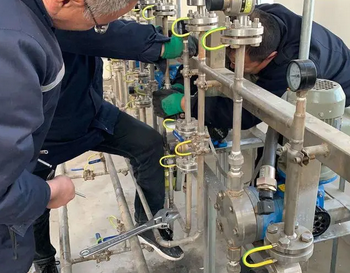Maintenance points of diaphragm pump
The maintenance points of diaphragm pumps mainly include the following aspects:
1. Installation and inspection
Correct installation: Ensure that the diaphragm pump is fully inspected before installation, including the integrity and correctness of each component, to avoid later failures caused by improper installation.
Pump valve inspection: Check whether the sealing ring of the pump valve is aging and deformed, whether the spring elasticity is reduced, and whether the valve port and valve core have defects such as wear and corrosion. During installation, the valve end face should be flush with the flange surface of the pump body to avoid recessing.
2. Component replacement and maintenance
Diaphragm replacement: When replacing the diaphragm, the disassembled pump head should be lifted in advance to prevent falling and damage. The diaphragm is a key component of the diaphragm pump, and its condition directly affects the performance of the pump.
Piston and packing ring: When disassembling the piston, a special pointed tool should be used to remove the packing ring from the groove, and be careful to avoid damaging the ring groove.
Turbine and worm inspection: Check whether the teeth of the turbine and worm are intact, and there should be no cracks and broken teeth. During installation, check the meshing contact to ensure smooth transmission.
3. Lubrication and sealing
Lubrication inspection: Check the lubrication condition of each component regularly to see if there are any parts with excessive wear. Add lubricant when necessary to reduce friction and wear.
Seal inspection: Check whether the seals of the pump body and pipeline are tight to prevent leakage caused by poor sealing. At the same time, pay attention to controlling the outlet pressure of the pump to avoid exceeding the bearing capacity of the diaphragm.
4. Operation and adjustment
Operation specification: Ensure the correct operation of the diaphragm pump to avoid damage caused by improper operation. Understand and follow the instruction manual and operating procedures of the equipment.
Disassembly and assembly of the adjustment mechanism: When disassembling and assembling the adjustment mechanism, calibrate the stroke length position (such as 5mm stroke length) to ensure that the measured stroke length is completely consistent with the scale.
5. Troubleshooting and handling
Pump leakage: Check whether the diaphragm, pump body seal and other components are damaged or aged, and replace the damaged parts in time.
The pump cannot start or is difficult to start: Check whether the motor, power supply, suction port and other components are normal, clean up the blockage and repair or replace the faulty parts.
The pump is noisy during operation: Check whether the pump body is firm, whether the blades and bearings are worn, and perform corresponding reinforcement or replacement.
The pump flow is unstable: Check whether there is blockage, bubble mixing or improper adjustment of the inlet valve inside the pump body, and perform corresponding cleaning and adjustment.
VI. Regular maintenance and cleaning
Regular maintenance: Regularly maintain the diaphragm pump, including cleaning, lubrication and tightening, to extend the service life of the equipment.
Clean the filter: Check whether the filter or air filter device at the air inlet end has impurities, and clean the filter regularly to keep the air flowing smoothly.
The maintenance points of the diaphragm pump cover many aspects. Through meticulous inspection and maintenance work, the normal operation and efficient operation of the diaphragm pump can be ensured.





